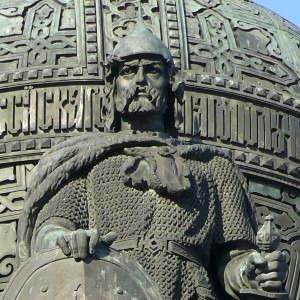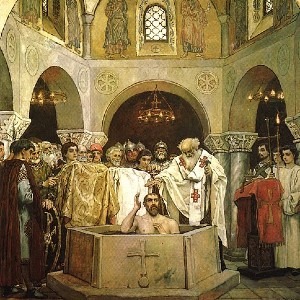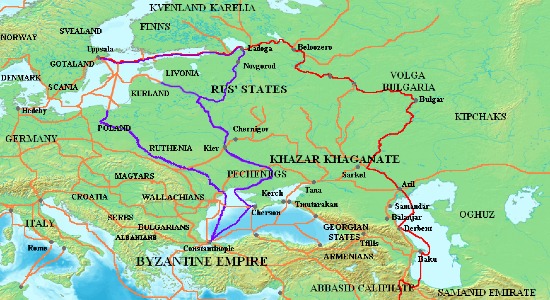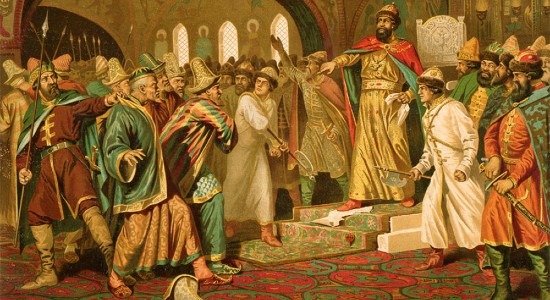MedievalReporter.com
Covering history's most marvelous millennium
Join our newsletter!

Covering history's most marvelous millennium
Covering history's most marvelous millennium
The Rus’ were a proud and unique people of mixed ethnic and cultural origin. They took to state-building along the many rivers of Eastern Europe – chiefly the Volga and the Dnieper. Their federation of city-states was governed by nobles of Scandinavian origin but encompassed Baltic, Slavic, Finno-Ugric, and even Turkic subjects.
The Rus’ established a dynasty that remained in power for centuries, ultimately bestowing their name to the modern countries of Russia and Belarus. Their influence, and their impact on Eurasia, was felt from Scotland to Iran.
This is a short intro from our Medieval Guidebook. Dive deeper into the subject by reading our articles about it.
Originally, yes.

A semi-legendary Viking chieftain called Rurik supposedly took to the seas in search of fame and fortune, around the middle of the ninth century CE. He understood that the riches of present-day Russia, Belarus and Ukraine could be exploited by sending Viking longboats up and down the many vast rivers crossing these lands. These waterways made for excellent routes towards the Black and Caspian Seas and the riches of Constantinople, with its insatiable demand for Rus’ products such as furs.
Rurik founded a city called Novgorod, meaning “new city”. Its perfect position on the Volkhov River, upstream from the Gulf of Finland, meant it was located inland enough to protect itself from other Viking raids. Simultaneously, it was connected exceptionally well to other streams leading south to rich Byzantine, Arab and Persian markets. Consequently, Novgorod grew into one of Europe’s largest cities during the Middle Ages. Rurik’s successors, called the Rurikid dynasty, oversaw its expansion and used Novgorod’s potential as a springboard for further east- and southward Rus’/Viking ambitions.
Already in 879, Rurik’s son Oleg seized power in the city of Kyiv, the capital of current-day Ukraine. Rurikid control of both Novgorod and Kyiv allowed them to expand their influence from the White to the Black Sea. Next to furs, peddling goods like honey and slaves made the Rurikids immensely rich. Kyiv soon outdid Novgorod in splendor and prosperity, so the state became known as the Kievan Rus’. It was Europe’s largest state at the time.


In need of something to bind his realm together, Rus’ ruler Vladimir the Great converted to Christianity. Impressed by the ceremonial rites in Constantinople, he and his people turned to Eastern Christianity. This firmly allied the Kievan Rus’ with the Byzantine Empire – underlined by Vladimir marrying an imperial princess. By the year 1000, the Rus’ identified increasingly as Slavic, leaving their Germanic Viking roots behind. Under Vladimir’s son, Yaroslav the Wise, the Kievan Rus’ experienced a golden age by controlling virtually every trade route passing through Eastern Europe.
However, the Rus’ state was a federation. Over time, the regional clans built up influence and autonomy. Disagreement over Yaroslav’s succession led to open warfare. During the rest of the 11th century, the federative state slowly yet violently imploded as it descended into civil war. The reason why the center (Kyiv) lost its hold on power was – once again – economic. As the Byzantine Empire staggered under the weight of repeated Seljuq attacks, the trade routes between Scandinavia and Constantinople decreased in importance and value.
A major competitor of Kyiv turned out to be where it all had started: Novgorod. As the first Rurikid city, it had always been jealous of being eclipsed by Kyiv. Now that the tide was turning, Novgorod seized the opportunity. It declared itself an independent republic and sent an army south that sacked Kyiv. The Rus’ fell apart into many different principalities that spent most of their time fighting one another.
When the Mongols stormed west during the 13th century, they had a relatively easy time subjugating the divided Rus’.

– advertisement –
– article continues below –
They played an important role in connecting “East” and “West”. Throughout the Early Middle Ages, a lot of haphazard migrations took place from Central Asia towards Eastern Europe. The Rus’ states consolidated this “land bridge”. They thus made the cultural interconnectedness less fleeting. Their states were meeting grounds for people of Viking, Germanic, Baltic, Slavic, Finno-Ugric, Turkic, Arabic and Byzantine descent.
Furthermore, the Rus’ played an important part in integrating the Viking world into the world economy. They were pioneers in extensively navigating the (Belo)russian and Ukranian rivers. In addition to the all-important furs, commodities like timber, amber and slaves flowed freely from Scandinavia through Rus’ lands to the Byzantine Empire and the various caliphates. In return, tons of silks, spices and gems went north. The Rus’ wove an intricate web of commercial routes, allowing merchandise to circulate from Imperial China to Viking England.
On the social-cultural front, the Rus’ themselves moved around a lot as well. They visited Baghdad and Central Asia in search of new wares. They were highly sought after by the Byzantine emperors as bodyguards. An Arab contemporary source even referred to them as “perfect physical specimens”. Evidently, the Rus’ left as deep an impression on Central Eurasia as their Viking brethren – albeit in a more violent manner – did on the West.

One Rus’ principality carefully yet stubbornly backpedaled against, negotiated with and ultimately overcame the Mongol overlordship. This was the Grand Duchy of Moscow. Over the course of centuries, it conquered the other Rus’ lands. Consequently, Russia, Belarus and Ukraine are sometimes understood as “successors” to the Rus’ legacy.

Disclosure: we work hard to provide you with exclusive medieval reports and guides. To make the Middle Ages accessible to everybody, we’d like this information to remain FREE. Therefore, some of the links below are affiliate links, meaning – at no additional cost to you – we will earn a small compensation if you click through.
Grab a short intro on another civilization from our Medieval Guidebook.